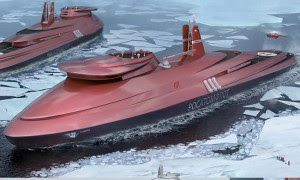This was the ice situation at the time:
The volume measure in the in the box, upper right, is the combination of the thickness (shown) and the extent, which is the measure usually being referred to when discussing disappearing sea ice.
The thickness is actually more important for a variety of reasons having to do with the physics of melting and the annual cycle of expansion and contraction of the ice sheet.
Here's the current situation, note especially the thickness in the Chukchi Sea and Bering Strait between Siberia and Alaska, top center:
Darker purple on this scale = up to 50 cm (19 inches) thicker ice. We'll come back to this point but first, the headline story from The Barents Observer:
The ships are on their way from China and South Korea and will have to break through up to 2 meter thick ice.
It is Sabetta, the new Russian LNG terminal in Yamal Peninsula, which is the destination of the two ships that now are breaking their way through the Northern Sea Route.
The «Boris Sokolov», a 214 meter long condensate tanker, on the 11 December set out from Nansha, China. One day later, it was joined by the «Boris Davydov», a 299 meter long LNG carrier.
The ships are now both on the list of vessels sailing on the Northern Sea Route as provided by the Northern Sea Route Administration (NSRA). However, none of the vessels are visible in their current position on ship tracking services like the MarineTraffic.The last line in the story is correct, the Toll had company because it was a first ever attempt and Teekay and Rosatom didn't want to risk the ship being trapped, but the tanker was able to break through on its own, which is why the two new ships are unescorted this year.
According to the NSRA, the ships are due to arrive in Sabetta on 20th January.
It is an extreme voyage. Sailing conditions in the area are highly complicated with thick ice. Data from the Russian Arctic and Antarctic Institute show that practically the whole East Siberian Sea is covered by up to two meter thick one-year ice as well as older more solid ice. Also the Laptev Sea and the northeastern parts of the Kara Sea have thick ice layers.
According to Reuters, the ships are sailing without icebreaker assistance. Previously, only the «Eduard Toll» has conducted a similar voyage at this time of year. The ship in January 2018 made it to Sabetta from South Korea. However, that was with support from a nuclear-powered icebreaker....MORE
Back to the Chukchi.
The summer of 2007 was the year of the big melt. That combined with some storms blowing from the Chukchi across to the Fram Strait—between Greenland and the Svalbard archipelago—center, that literally flushed the ice out of the Arctic basin,
By the next year, 2008, there was very little multi-year ice that had survived along the Northern Sea Route:
Fortunately the multi-year ice is coming back. Here's the picture from the Russian perspective"
The rust-colored ice has survived at least one melt season which is good for the Arctic, not so good for the LNG shippers but keeps the shipyards busy cranking out heavier and more powerful icebreakers.
Russia has three under construction now that will surpass 50 Years of Victory, currently the world's largest at 25,000 deadweight tons displacement. Following those three are plans for at least two 55,000 dwt displacement icebreakers that look for all the world like they were designed for an oligarch:
An artists rendition of the Lider Icebreaker.
(Photo: Rosatom/Unified Shipbuilding Corporation)
